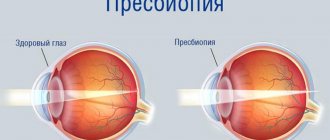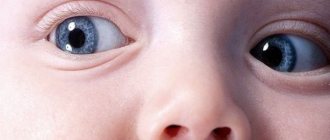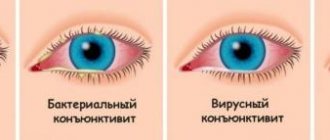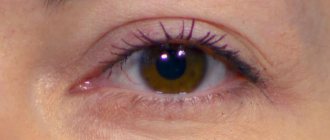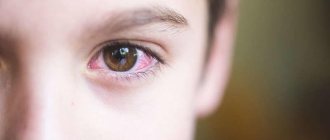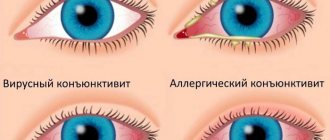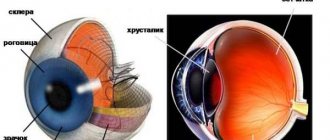Why does a child cross his eyes?
There can be many reasons for the appearance of strabismus in children. Even a qualified doctor cannot always determine exactly why a child squints his eyes. Sometimes the disease is a consequence of various visual problems, such as cataracts, severe farsightedness or glaucoma. Children with farsightedness may deliberately squint their eyes in order to see more clearly.
Strabismus (strabismus) is the inability to focus on an object of interest with both eyes at the same time. Normally, the eye muscles should move together, which allows you to focus your gaze in one place.
With strabismus, muscle function is impaired, one or both eyes deviate from the central axis, that is, they look in different directions, and the brain fails to combine two visible images into one.
With strabismus, the work of the eye muscles is impaired, one or both eyes deviate from the central axis
Minor deviations are observed in almost all infants. Newborns and infants up to 2–3 months cannot yet fix their gaze due to weakness of the eye muscles and insufficient control over them, so a slight squint at this age is a variant of the norm. By 3–6 months, the baby begins to coordinate eye movements.
If a six-month-old child’s eyes continue to “float” and look in different directions, you need to show the baby to a specialist.
It is quite difficult to answer the question of why a child has one eye squint. This pathology is often associated with the age of the baby.
For example, a newborn's eyes may move in different directions due to poor ocular motor control. This is due to the fact that the eye muscles do not yet obey the baby very well.
And he needs to learn to control the subtlest eye movements to achieve precise synchronicity. That is, in other words, the child needs to learn to look and see correctly.
The posterior longitudinal fasciculus system is responsible for the correct movement of children's eyes. If hypoxia or injury occurs during pregnancy or childbirth, microscopic hemorrhages occur in the corresponding nerve centers.
In such cases, the child is born with a persistent form of strabismus. This form includes divergent strabismus (when one eye is directed towards the temple), convergent strabismus (when the baby’s gaze is directed towards the nose) and vertical strabismus (the gaze of one eye is directed up or down).
If a child has one eye that squints constantly and does not change its character (that is, the deviated eye remains in a certain position), then you should contact a neurologist and ophthalmologist for help. With proper and timely treatment, all symptoms and signs of strabismus disappear.
There are also cases when the condition of strabismus goes away on its own. This is due to the fact that the symmetrical halves of the facial skeleton of a newborn baby are located at a small angle to each other.
They may not immediately take the correct position. In this regard, in the first months of a child’s life, it often seems that his eyes converge and diverge a little.
In such cases, medical therapy will not be required. This will all go away with age.
If a child has one eye squinting due to functional strabismus, then parents should not worry either. The fact is that the baby is still learning to hold and focus his gaze. This type of strabismus should go away in two to three months. And if this does not happen, then you should seek advice from a specialist.
Strabismus in children under one year of age is very common. Weakness of the eye muscles and lack of control over them cause different movements of the eyeballs.
Prognosis and prevention
Accommodation spasm can be successfully treated, as it is a completely reversible functional disorder.
With the help of medications, you can quickly eliminate spasm of the ciliary muscle through forced relaxation. To achieve a lasting effect, it is necessary to carry out a full range of treatment, eliminating the causes contributing to the development of spasm of accommodation. Preventive measures that can prevent the development of accommodation spasm are as follows:
- organization of a good night's rest;
- playing sports;
- proper nutrition;
- maintaining correct posture while working;
- selection of corrective optics in the presence of astigmatism, farsightedness;
- hardening of the body;
- taking vitamins for the eyes.
Spasm of accommodation is a functional disorder associated with improper functioning of the ciliary muscle, which constantly contracts. These contractions cause the eye to automatically focus on various objects located both far and near. If detected early, the disease can be easily corrected. If left untreated, it leads to decreased visual acuity. Therefore, if you notice symptoms characteristic of false myopia, you should consult an ophthalmologist.
Author of the article: Bakhareva Elena Sergeevna, specialist for the website glazalik.ru Share your experience and opinion in the comments.
A child has one eye squinting – the reason for this phenomenon and how to correct the defect?
Strabismus is a complex vision defect in children, in which both eyes are unable to look at the same point at the same time. If a child begins to squint his eye, then we can talk about a pathology such as strabismus.
Table of contents:
- A child has one eye squinting – the reason for this phenomenon and how to correct the defect?
- Types of strabismus in children
- Why does a child cross his eyes?
- The child began to squint his eye - ways to treat the disease
- The child has one eye squinting
- The child's eye squints. What to do? Treatment of childhood strabismus
- What are the possible causes of lazy eye?
- Treatment of strabismus in children
- What to do if your baby's eyes are crossed?
- What it is?
- Causes
- When to sound the alarm?
- Self-diagnosis
- Treatment
- Strabismus in children: types, signs, treatment methods
- Description of the disease
- Children's strabismus - video
- Classification of strabismus: divergent, vertical, convergent, paralytic, concomitant, etc.
- Types of strabismus - gallery
- Causes of the development of the disease in newborns, infants and older children
- Symptoms of the disease in children and adolescents
- Diagnostic methods: how to determine congenital and acquired strabismus
- Treatment methods in hospital and at home
- Conservative therapy
- Occlusion
- Special glasses
- Medications
- Hardware treatment
- Eye exercises
- Eye gymnastics - video
- Surgical treatment: features, indications for surgery, rehabilitation after surgery
- Treatment prognosis and possible complications
- Doctor Komarovsky about strabismus - video
- Lifestyle during illness
- Prevention
And most often it manifests itself in early childhood.
If you notice that your child’s eyes have begun to squint, you should not console yourself with the thought that the problem will disappear on its own with age. Without special therapeutic therapy, strabismus (strabismus) can lead to severe consequences with the baby's vision.
For example, in cases where one of the squinting eyes is not involved, the child’s visual ability can deteriorate significantly, which will provoke the development of amblyopia (the so-called
"lazy eye" syndrome). In addition, the development of strabismus can negatively affect the child’s self-esteem, because it is closely related not only to the function of vision, but also to the appearance of the baby.
When a child has one eye squint, other children may start calling him names and teasing him. In such situations, in addition to timely treatment, the baby will also need psychological support from the parents.
Statistics tell us that three out of a hundred people have a lazy eye problem. And, of course, the sooner the pathology is detected, the more effective and easier it will be to cope with it.
A crossed eye may be associated with a neurological problem. This reason is quite common among the youngest children. With the correct behavior of adults who will try to create a calm, healthy environment at home, this problem will soon go away.
Another cause may be intracranial pressure. This is also not difficult to deal with - any pediatrician will prescribe adequate treatment, as a result of which the eyes will fall into place.
Strabismus can also be inherited. In this case, it is necessary to show the child to an ophthalmologist as soon as possible in order to properly check his vision.
To check if your baby actually has strabismus. The following methods can be applied.
Place the child's head straight and see if the light is reflected symmetrically in his pupils. If it is asymmetrical, there is strabismus. This should be noticeable in photographs as well. If everything is fine in the photo, then your worries are in vain.
Another test method: fix the child's head straight and attract his attention with some toy located to the right or left of his eyes. In this case, the child should move both eyes normally in both directions, and neither eye should squint. Then there is no squint.
Myositis of the eye - what affects it and how?
The occurrence of muscle inflammation is influenced by the presence of:
- infectious diseases,
- infectious infections that are parasitic in nature,
- chronic process, which contributes to the appearance of poisoning of the body,
- work-related ailments of the patient that appear due to prolonged muscle tension or uncomfortable body position while at work,
- prior injury or non-specific physical activity, frequent exposure to cold, muscle cramps, which can contribute to the development of myositis due to injury,
- hypothermia (because of this, inflammation often develops in children),
- mental overstrain or stressful situations that cause the occurrence of responses of a certain nature in the patient’s body, permanent muscle tension.
Types of strabismus in children
What parents should do when their child has one eye squint can best be advised by the attending pediatrician. In any case, therapy should be comprehensive and carried out as early as possible. The younger your baby is, the more likely he is to cure the disease.
Most often, the following methods are used for treatment:
- Sealing a healthy eye (for a certain time). This method helps to straighten the sore eye and strengthen it. The pediatrician may prescribe the child to wear a bandage temporarily or at intervals of several weeks/months.
- Glasses. Wearing contact lenses or glasses corrects moderate strabismus in many cases.
- Surgery. If a child’s eyes begin to squint, sometimes this is the only expedient method to improve vision and straighten the eye muscles. In most cases, just one operation is enough, but if there is an urgent need, it is repeated several years later. After surgery, the child may need to wear additional glasses for some time.
In addition to the above methods, there are various eye exercises, as well as drug treatment. Ophthalmological centers have special medical rooms in which your child can perform a number of therapeutic exercises using specific eye devices and simulators.
By attending such classes, children increase their chances of getting rid of strabismus several times, especially if they perform the exercises under the supervision of a competent specialist.
It is important for parents to remember that if a child has a squint in one eye, they will need high-quality medical therapy, which can last for many months, which means they will need a lot of patience. In addition, it is necessary to take into account the fact that with this pathology there are no identical cases.
Accordingly, in the treatment of strabismus, a purely individual approach of specialists plays a significant role in developing treatment methods for each patient. Let us also remember that surgical operations are carried out only after conventional treatment methods have been undertaken and only at the age of four years.
Nothing is visible, before five years all your suspicions will definitely pass. My little one has the same problem, but as for me, it’s even worse than yours, but when we went to the doctor, he said everything was fine. Moreover, apart from a sticker on your eye, they will not do anything for you until you are five years old, even if you have this strabismus. So let's now hope together that everything will be fine with our children.
girls, hello everyone, my son also has a problem in one eye, but it started a week ago, the right eye started to squint, we are 7 months old, this has never happened before, what could it be? I was at the local hospital, but the ophthalmologist and neuropathologist didn’t even bother to look, they sent me to the regional children’s hospital. Has anyone encountered such a case?
My eldest's eye was squinted, then the other. We saw an ophthalmologist for a year, she saw that the right one was mowing, 5 minutes later we went to the ENT specialist, the left one was already mowing (ENT noted) They still have a weak ligamentous apparatus, they say it returns to normal by the age of 2, for us a little later it all went away, I didn’t even I noticed when, don't worry.
You have a baby - healthy and beautiful. Are you happy! But then weeks pass, and you begin to notice that the child’s eyes are a little squinted, or wander. Sometimes one eye squints, sometimes both. This phenomenon is also called “lazy eye”. What is the reason for this and what to do?
We can immediately say that childhood strabismus in infancy is not a diagnosis and does not at all mean that your child has vision problems. Strabismus in newborns is common.
The fact is that immediately after birth a little person’s muscles, including the eye ones, are still weak, the baby does not yet know how to control them, so the eyes “wander” - first one, then the other, then both at once.
This phenomenon can last up to six months - as you grow older, the muscles become stronger, the eyes begin to focus together, and the squint goes away on its own.
But if the eyes continue to squint even at an older age, then the consultation and help of an ophthalmologist is already needed.
If there is actual strabismus, it is not at all cosmetically dangerous: our brain “adds up” the image using information from both eyes at once. but if at the same time one of them moves incorrectly, then it “gets in the way,” so the brain automatically turns it off.
To prevent the development of strabismus, it is recommended to change the position of the baby in the bed - put his head in one direction or the other. In addition, the child should play on the floor so that he can raise his eyes, which will thus train in movement.
To treat strabismus, occlusion is used - a method in which the child is put on a bandage over the healthy eye in order to force the “lazy” eye to work, or is covered with a special children’s eye patch called Occluder.
By wearing a patch or patch on the good eye for a certain amount of time every day, the child learns to rely more on the lazy eye. At the same time, it is very important to monitor the child so that he does not remove the bandage.
If he removes the bandage even just a few minutes before the appointed time, make him put it back on. If you did not notice when the child took off the bandage, put it on again and count down the time again.
Children wear bandages and plasters with displeasure, so your task is to explain to him and show him clearly why this is necessary. To do this, you can cover the healthy eye with your hand and ask if it sees well, and then explain that wearing a patch will make the unhealthy eye as healthy and seeing as the other.
Be careful not to let your child peek.
The sooner you start treatment, the less likely the strabismus will become permanent.
MOST INTERESTING NEWS
When the baby has just been born, young parents do not always know all the features of the tiny organism. So, having seen their baby’s eyes “running” to the sides, mothers and fathers attribute this phenomenon to visual impairment. Of course, this can terrify even experienced mothers, but is it worth drawing any conclusions if the baby is not yet two months old?
- The main sign of pathology is visible strabismus, when the disorder is determined visually.
- The child involuntarily tilts his head at a certain angle, looking at something, and squints one eye.
- The baby's perception of the depth of space is impaired, he bumps into objects and falls.
How to cure eye myositis?
Diagnosing this disease is not difficult. A specialist can make an accurate diagnosis using the patient’s medical history.
To see a detailed picture, you can undergo electromyography. In this way, the patient’s bioelectric impulses are examined. They also take a general blood test so that the inflammatory process can be detected.
Before determining treatment methods, in each individual situation, the specialist becomes familiar with the nature of the disease or similar unpleasant sensations.
The treatment of myositis itself is divided into pathogenetic and symptomatic. Pathogenetic treatment deals with curing the cause of the disease. Symptomatic treatment alleviates the patient's condition.
Among the main methods for the treatment of eye myositis are:
- physiotherapy treatment;
- physical therapy treatment;
- massage (suitable for any form of disease, if the form of the disease is not purulent);
- protein diet treatment;
- treatment with anti-inflammatory drugs;
- treatment with medications (painkillers and vascular drugs).
Prednisolone, Prednisone, Triamcinolone or Dexamethasone have a good effect during the treatment of inflammatory eye diseases. When the disease is severe, in addition to steroids, it is recommended to use salicylates (to make a person sweat when they wrap him up), Amidopyrine, Butadione, and physiotherapy (diathermy, diadynamics).
To avoid re-development of myositis, the infectious focus should be sanitized and the body should be hardened.
Let's summarize the disease
To prevent myositis, every person should take good care of their health.
Don't forget to pay attention to your body. All this will be useful in eliminating a number of factors. These are factors that can contribute to the appearance of such inflammation. Otherwise, the disease can have very serious consequences for the body (muscles can simply atrophy). Muscles should not be overstrained when performing any work. The same applies to situations where physical activity takes place (sports, for example). Hypothermia must be avoided. Drafts are undesirable. Work should not be performed in cold rooms. Optimal temperatures should be maintained.
Experts recommend treating colds and infections correctly and in a timely manner. This will also prevent the disease. Do not neglect the doctor's instructions. By contacting specialists on time, you can begin effective treatment. Then treating the disease will be simpler and easier. Recovery will come quickly.
source
Diagnostic methods: how to determine congenital and acquired strabismus
The method for determining strabismus at home is based on the ability of the pupils of the eye to reflect bright light. Therefore, self-diagnosis of a baby can be carried out in the following ways:
- Shine a not very bright flashlight in the direction of the child’s face (distance cm): if the light is reflected synchronously in the pupils, then everything is in order with the eye muscles. But if the reflection of light is not the same in the two pupils, you need to go with the child to an ophthalmologist.
- Take a photo of the baby with a flash while he looks into the lens. The problem can be recognized in the same way as in the first method.
Treatment
The sooner treatment for true strabismus is started, the less likely the child is to lose visual acuity and remain cross-eyed for life. Therefore, ophthalmologists usually prescribe complex therapy immediately after identifying the problem, and at the age of 2 years, children are already successfully operated on. Treatment of strabismus includes the following techniques:
- orthopedic therapy helps to correct the brain in maintaining the functioning of the eye muscles. Classes can be conducted either at a computer using special programs or on orthopedic simulators. The only disadvantage of this treatment is that only older children can master it - after 4 years;
- Reflexology is a technique of acupressure, with which a specialist acts on the nerve centers. They, in turn, regulate the coordination of the muscles of the eyeball. In complex therapy, it allows not only not to lose vision, but in some cases to improve it and keep the eye muscles in good shape;
- the operation is performed after the age of two, truncating the long muscle of the eye, as a result of which the pupils stop scattering due to the previously relaxed state;
- for children of kindergarten age, it is recommended to visit adapted child development centers, where there are special rooms with orthopedic simulators, ophthalmologists who regularly examine children and conduct corrective classes with them;
- sometimes children are prescribed electrophoresis to relax muscles and improve nerve conduction;
- Occlusion of a healthy eye helps to activate the work of pathologically developed tissues of the second eye. For this, both ordinary bandages and special children's eye patches are used;
- may prescribe osteopathic therapy, which is more related to alternative medicine, but gives amazing results. This treatment involves influencing the structures and fluids of the human body using the hands of an osteopath. As a result, the tissues relax, the passage of nerve impulses improves, and the muscles become toned, which is extremely important for strabismus in infants.
If strabismus is not treated, then the children's brain responds to pathological processes in the eye muscles with compensatory mechanisms in the brain, which over time leads to serious problems with vision, up to its severe decrease. Therefore, even if you suspect functional strabismus, it is better to visit a specialist for preventive purposes, so as not to aggravate the child’s problem in the future.
A few words about pathologies of the eye muscles
Diseases of the muscular system of the eyes
The muscular structure of the eyes is striated muscle fibers that provide the necessary movement of organs inside the orbit to realize a broad vision of the environment.
The visual muscle system includes:
- superior obliques;
- upper straight;
- inferior obliques;
- lower straight;
- lateral;
- and medial fibers.
Perhaps, judging by their name, every reader was able to understand their location relative to the eye organ and the main functions.
Note that the muscular system of the eyes is controlled by three cranial nerves:
- block;
- oculomotor;
- abductor
As a rule, it is the incorrect functioning of the nerve endings that provokes the development of problems in the muscular apparatus of the visual system.
Directly pathological defects of the muscles themselves occur infrequently.
In any case, improper functioning of the eye muscles can provoke a number of unpleasant manifestations, namely:
- partial or complete blocking of the movement of the visual organs in specific directions;
- impaired focusing of vision;
- reduction of its sharpness and objectivity.
As a result, muscle pathologies provoke the development of visual dysfunctions, which can not only reduce the patient’s quality of life, but also make him disabled.
For general information, we note that among the most common pathologies of the eye muscles are myasthenia gravis (weakness of the fibers), paralysis (improper functioning of the motor nerves), spasm (impaired muscle contractility) and various types of congenital anomalies (absence or damage to specific fibers).
Treatment of strabismus in children
The sooner you start correcting strabismus, the better. The success of treatment directly depends on this. The required type of treatment and its duration are determined by the doctor after a series of examinations of the patient. Treatment may vary. The doctor may suggest:
- eye exercises for strabismus in children;
- correction with glasses;
- pleoptics;
- hardware treatment of strabismus in children;
- surgical method.
What kind of exercises can there be?
Eye gymnastics is a very effective, free and painless method. However, there is one drawback - children do not want to do it.
Constant monitoring is needed. Mom can do it together with her baby, turning it into a game.
Exercises should be done with glasses, which will be selected for you by your doctor. Exercises should be performed about 10 times a day for 15-20 minutes.
It is very important. If you ignore any points, there will be no positive results.
Before performing basic exercises, you need to stretch your eye muscles. To do this, it is also recommended to blink frequently and close your eyes several times - this will help moisturize your eyes. Next, move your eyes in different directions. You can draw imaginary numbers and letters with your eyes.
There are many exercises to correct strabismus. They are also aimed at correcting visual acuity. Examples of such activities could be alternately focusing the gaze on objects that are close and far away. To interest your child, you can use bright cubes, fruits or candies.
How can optical correction help? From the age of 9 months, your child can wear glasses. The lenses in glasses are selected in such a way as to correct vision problems.
In combination with exercises, glasses give a very rapid and positive effect. Visual acuity and strabismus are corrected.
Glasses also prevent the development of lazy eye syndrome. This is when the diseased eye gradually loses visual acuity due to the fact that there is no load on it.
What is pleoptics? Pleoptics is used to treat lazy eye syndrome. Its essence is that a healthy, well-seeing eye is covered with a dark, opaque material so that the child strains the squinting eye as much as possible.
Since all the work is now on the affected eye, he is gradually regaining visual acuity. If the strabismus is bilateral, alternate closure of the eye that sees better is used until complete recovery.
How is hardware treatment performed?
Special equipment can be used to treat strabismus in children. In this case, up to 10 procedures (which are absolutely painless) will be needed to completely straighten the eye and restore vision. This method is suitable even for the youngest children.
How does surgical treatment occur? Surgery can help the eye return to its original position. However, visual acuity does not improve.
After the end of the rehabilitation period (one week), it will also be necessary to treat vision problems and strengthen the eye muscles so that strabismus does not return to the child. One method is to shorten the eye muscle, which is in an unnatural state.
You can also move the attachment point of the muscle on the eye so that it pulls it in a slightly different direction.
In the 21st century, there is no need to be afraid of surgery. Thanks to modern technologies and equipment, operations are well tolerated and excellent results are achieved.
At the end of the operation, the patient must follow these rules:
- the use of drops with an anti-inflammatory effect, prescribed by the doctor;
- you need to especially protect your eyes from dust, water and foreign objects (there is a high risk of infection);
- limit physical activity for 2-3 weeks;
- Limit eye strain for about a week.
Depending on the causes of the disease and the severity of its course, the doctor will prescribe appropriate treatment. It is carried out both in a hospital setting (if strabismus is accompanied by other eye pathologies) and at home.
Conservative therapy
It is necessary to begin treatment of the pathology as early as possible, because the eye that deviates to the side begins to see worse and worse over time. With a mild form of strabismus, you can try to eliminate the problem using conservative therapy.
Occlusion
To correct the trajectory of the gaze of the affected eye, in some cases it is enough to increase the load on it. For this purpose, the healthy eye is temporarily closed with a special shutter (occluder) so that the baby begins to actively use the squinting eye. With bilateral strabismus, both eyes are glued alternately.
The essence of the occlusion method is to make the affected eye work
For the same purpose, special eye drops can be prescribed. Such drugs, when instilled, worsen vision in the healthy eye, and the affected one begins to work harder. But in most cases, such treatment is not enough, so it needs to be combined with other methods.
To achieve a positive effect, treatment of the pathology must begin as early as possible, otherwise irreversible vision loss may occur. The most favorable prognosis is observed with the concomitant form of strabismus; late-diagnosed paralytic strabismus is the most difficult to correct.
In the absence of treatment, in addition to a cosmetic defect, more serious complications may develop, in particular amblyopia - a sharp decrease in vision in the squinting eye, without signs of organic lesions of the fundus. Such a process may be irreversible. In addition, there is a possibility of complete dysfunction of the diseased eye.
If a child has a squint in one eye, the attending physician will tell you what to do. In any situation, treatment therapy should begin as early as possible and be comprehensive.
Because the younger the child’s age, the greater his chances of getting rid of the disease. For therapeutic therapy, in most cases, methods such as wearing glasses, temporarily sealing one healthy eye, and surgical treatment are used.
Wearing properly fitted glasses or contact lenses in most cases helps correct only moderate strabismus. Temporarily sealing one healthy eye makes it possible to make the diseased eye stronger and straighten the gaze. In this case, the attending physician may prescribe constant wearing of the bandage or for several weeks, or even months.
Surgery is also performed if the child has a squint in one eye, which makes it possible to realign the eye muscles. At the same time, vision itself improves. Often it will be enough to perform the operation once. But if necessary, it can be repeated after a few years. And after surgery, your child may need to wear glasses.
In addition, there are drug treatments and various eye exercises. In ophthalmological centers there are special medical rooms in which children conduct classes on specific eye simulators and devices. By attending such classes, a child significantly increases the chances of getting rid of strabismus.
Treatment should begin immediately after diagnosis. Moreover, this disease manifests itself before the age of 3 years.
If you do not start solving the problem in time, it will only get worse in the future.
There are several methods that are used to eradicate this disease:
- surgical;
- therapeutic.
Therapeutic treatments
The disease can be treated not only with surgery, but also with less scary methods.
Therapeutic methods consist of:
- diagnostics;
- treatment with glasses, lenses;
- hardware procedures;
- orthoptic and diploptic treatment;
- strengthening monocular and binocular functions.
Important: Be sure to carry out treatment from a specialist - an ophthalmologist. He will conduct a vision test, determine the type of heterotropia and prescribe special treatment.
It is worth considering that recovery does not happen quickly. Fighting the disease can take up to 2 years.
Very often, glasses are prescribed that need to be worn constantly. After 3 weeks of wearing glasses, you can begin the next stage of treatment.
It is necessary to equalize the visual acuity of both eyes. For this purpose, the vision of a good-seeing eye is specifically impaired. With this method, the other eye, which sees poorly, will start working faster.
To do this, glue an eye patch or glasses. Depending on the type and degree of strabismus, such a bandage may be prescribed for several hours or for the whole day.
It is not possible to completely cure the disease at home, but you can do special exercises for the eyes.
To perform the exercises, the baby must not be tired.
Each lesson should take no more than 20-25 minutes. You should spend up to 2 hours a day on practice.
Of course, it all depends on the degree of heterotropia in the child.
With small children you need to do simple and exciting gymnastics.
Non-traditional methods of treatment include the use of chocolate, herbal infusions, phyto-drops, etc.
Dark chocolate will help strengthen the muscles that support the eyeballs. It is worth giving your baby sweets within an hour after breakfast and lunch, 4 slices each. This approach can only be tried with those who are not allergic to this type of sweet.
Eye fatigue syndrome
Eye fatigue syndrome is a very unpleasant phenomenon, especially common among those who spend their entire working day at a desk or computer. Even children today are familiar with this feeling firsthand, as they literally cannot be torn away from modern gadgets and devices.
Most modern professions involve long hours of monotonous work, with a daily significant amount of information, the assimilation of which requires constant eye strain and even eye strain. This problem has not escaped schoolchildren, who spend almost all their days sitting in front of books or a monitor. And this is only during the learning process, let alone computer games, as well as other entertainment outside of school. However, even adults, having returned from work, happily settle down, some in front of the TV screen, some in front of the computer monitor. It is no wonder that in recent years, an increasing number of people need vision correction. This is caused by the intense rhythm of modern work life, stress, overload, attachment to electronic “assistants”, reading in transport or lying at home.
This lifestyle leads to a condition called eye fatigue syndrome, which is accompanied by the following symptoms:
- Redness (hyperemia) and irritation of the whites of the eyes;
- Pain in the eyes;
- Inability to concentrate with your gaze on a specific object;
- Pain, dryness and feeling of “sand or a foreign object in the eyes”;
- Headache, increased intraocular and blood pressure.
Eye fatigue syndrome, called asthenopia in ophthalmology, occurs as a result of intense visual activity, which continues for a long time, in low or, conversely, very bright lighting, in improperly designed (distracting) interiors, in an uncomfortable working position, as well as the tiring effect of the screen computer or TV. It is accompanied by a decrease in the performance of the oculomotor muscles when it is necessary to shift the gaze from one object to another and manifests itself:
- Cloudiness and vagueness of small details, numbers or letters;
- Cutting and pain in the eyes and temporal region;
- Photophobia and lacrimation.
Chronic eye fatigue will inevitably lead to the progression of myopia, farsightedness or the occurrence of an accommodation spasm, which will cause a weakening of visual acuity. And if chronic eye fatigue is aggravated by the presence of a bad habit of smoking, then sooner or later macular degeneration or even damage to the optic nerve will occur, which leads to complete blindness.
How can you protect yourself from such terrible consequences of eye fatigue syndrome and help your child? This issue is especially acute today, requiring a careful approach to the problem in order to avoid loss of visual functions.
Actually, despite the severity of its complications, visual fatigue syndrome itself does not require special treatment. It is enough just to give timely, proper rest to the tired organ of vision and make its difficult “life” as easy as possible for it. To do this, it is necessary to properly organize the workplace and space, regularly ventilate the room, provide optimal lighting, adjust the brightness and contrast of the computer monitor and TV, take frequent breaks when working for a long time at close range and look into the distance (preferably outside the window), go to bed on time and get at least 8 hours of sleep at night. It is also necessary to perform eye exercises, including palming, at least twice a day, and from time to time “pamper” your eyes with a massage and compresses with decoctions of medicinal herbs. It is ideal to include foods that are good for healthy vision in your diet and spend more time in the fresh air.
In the medical department, everyone can undergo examination using the most modern diagnostic equipment, and based on the results, receive advice from a highly qualified specialist. We are open seven days a week and work daily from 9 a.m. to 9 p.m. Our specialists will help identify the cause of vision loss and provide competent treatment for identified pathologies.
Various types of rings and segments are implanted into the MGC for keratoconus. You can find out the cost of various implants and their installation, and make an appointment at the Moscow Eye Clinic by calling the multi-line phone number 8 (800) 777-38-81 (daily from 9:00 to 21:00, free for mobile phones and regions of the Russian Federation) or using the online registration form.
Mironova Irina Sergeevna
Prevention
How to avoid developing strabismus in a child? It is necessary to pay attention to the child’s behavior, how he looks closely, if there is the presence of any eye diseases, treat them immediately, avoid complications, make sure that the child does not overload his vision (take him away from the TV), visit an ophthalmologist with preventive inspections.
Do not self-medicate. Only a doctor can select glasses and prescribe medications.
You should NOT risk your baby's health.
Symptoms of orbital myositis
In the idiopathic form, the first manifestations occur against the background of complete well-being. Patients complain of acute pain in the orbital area and a feeling of severe muscle weakness. Swelling of the eyelids is visually determined. The orbital fissure narrows due to secondary ptosis. The mobility of the eyelids and eyeball is severely limited or impossible. With unilateral damage, patients note double vision. The pain syndrome increases when the eyes move towards the lesion. The phenomenon of exophthalmos progresses very quickly. An increase in the volume of the eye muscles is accompanied by a feeling of bursting pain in the orbit.
A headache appears on the affected side, which intensifies when trying to move the eyeballs. The conjunctiva is hyperemic. The line of transition of the orbital conjunctiva to the palpebral conjunctiva is smoothed due to edema. Deterioration of vision occurs only with compression of the optic disc in patients with a high degree of exophthalmos. Clinical manifestations increase with general hypothermia of the body and emotional stress. In severe cases, there may be a slight increase in body temperature and swelling of the entire periorbital area.
With secondary orbital myositis, there is a clear relationship between the development of symptoms of the disease and the action of certain factors (hypothermia, correction of strabismus, intoxication). With traumatic or iatrogenic origin of the pathology, eye reposition is almost impossible. In patients with intoxication, symptoms are temporary, and elimination of the etiological factor allows for stable clinical remission. Secondary myositis, which occurs against the background of hypothermia, is often characterized by a recurrent course.

